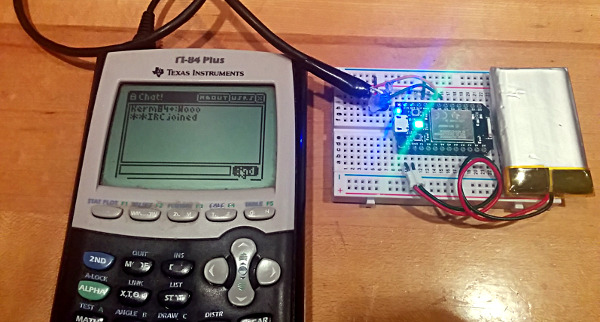Just before the days where every high school student had a cell phone, everyone in class had a TI graphing calculator. In some ways this was better than a cell phone: If you wanted to play BlockDude instead of doing trig identities, this was much more discrete. The only downside is that the TI calculators can’t easily communicate to each other like cell phones can. [Christopher] has solved this problem with his latest project which provides Wi-Fi functionality to a TI graphing calculator, and has much greater aspirations than helping teenagers waste time in pre-calculus classes.
The boards are based around a Spark Core Wi-Fi development board which is (appropriately) built around a TI CC3000 chip and a STM32F103 microcontroller. The goal of the project is to connect the calculators directly to the Global CALCnet network without needing a separate computer as a go-between. These boards made it easy to get the original Arduino-based code modified and running on the new hardware.
After a TI-BASIC program is loaded on the graphing calculator, it is able to input the credentials for the LAN and access the internet where all kinds of great calculator resources are available through the Global CALCnet. This is a great project to make the math workhorse of the classroom even more useful to students. Or, if you’re bored with trig identities again, you can also run a port of DOOM.
















Finally, a better way to cheat on exams!
Man, I’m unexpectedly nostalgic for my calculator days. My TI-83+ is how I learned to program, and I wasted sooooo much time messing around on that thing. It got to the point where I could touch type, without taking my eyes off the screen.
At one point I had a math teacher who understood the difference between clearing ram and clearing all memory. I cleared all memory and then stored the screen to a picture. I’d show that to her when she did the pre-test anti cheating check so I wouldn’t lose all my games.
Memories!
I had a teacher that went one step further and did the memory clearing himself because students had made screens that showed the memory was clear, when it wasn’t. I naturally wrote a program that emulated the memory clearing screens and even displayed blank program menus etc. in case he did a secondary verification.
please share!
Our school used a system where a companion calculator was used to clear all memory and disable the program menu until a variable was transferred to the calculator. Let’s just say it was easy to create a spoofing program that started and emulated the clearing and locking so no one was the wiser. Plus I always has the transfer cables on hand to unlock everyone elses calculators.
Why couldnt the esp2866 and cc3300 come out 2 years ago that way I might have been able to be entertained during my finals…
Eh… These hacks are cute but there is a reason why they charge college students $100 or so for an ancient CPU and gray scale screen – colleges “trust” them. Since there are so many of these calculator communication hacks, my college pretty much does not allow you to use a calculator at all on any math or engineering exam.
This particular hack was motivated by the wish to design and construct a full network stack with a custom network protocol for the calculators rather than by a wish to communicate or cheat. I and Cemetech are firmly against any kind of cheating with our projects. As a PhD student in networking and distributed systems by day, these side projects are a fun way to explore the challenges of implementing “modern” functions on what you correctly point out is 1980s-era spec hardware in z80 assembly.
Sooooo, will the calculator need ads to operate?
I wonder how hard this would be to fit inside the case with a small switch to turn it on and off. It’d be really neat to have it built in and inconspicuous so that you can get it on CALCnet.
The hacker in me says that in the TI-83 Plus/Silver Edition models, there’s plenty of space in the back for a Spark Core and a Li-Poly battery, but the teacher in me reminds you that that’s a very bad idea if your intent is to cheat.
Why go with sparkcore? just use an ESP8266. you have a general purpose micro on the wifi board already, no need to complicate things. There’s a ton of room in there to cram a module. Bonus points if you made it easily instsallable and just press-fit over some existing contacts so no room for buggy solder jobs.
why bad idea?
discrete != discreet ffs.
Discreet is actually not the same thing as discrete. Discrete is a mathematical concept, ffs… Discreet means to be careful/stealthy…
I cheated so much with graphic calculators <3 LOL love it.
Soon Wolfram Alpha is gonna need better servers. :)
“Just before the days where every high school student had a cell phone, everyone in class had a TI graphing calculator.”
Wait, people are allowed cell phones in class? Everyone still has graphics calculators for maths, because phones aren’t allowed.
That rule only applies to Math classes… In all other classes, smartphones are usually allowed
Plenty of people have their phones in my math classes…
can you use a Wi-Fi photon 2 instead of a spark core because I’m having trouble finding buyable ones?
and also, I’m having a hard time with the stupid gCn client. it won’t display anything I tried command prompt, but it won’t display anything so, update the software.